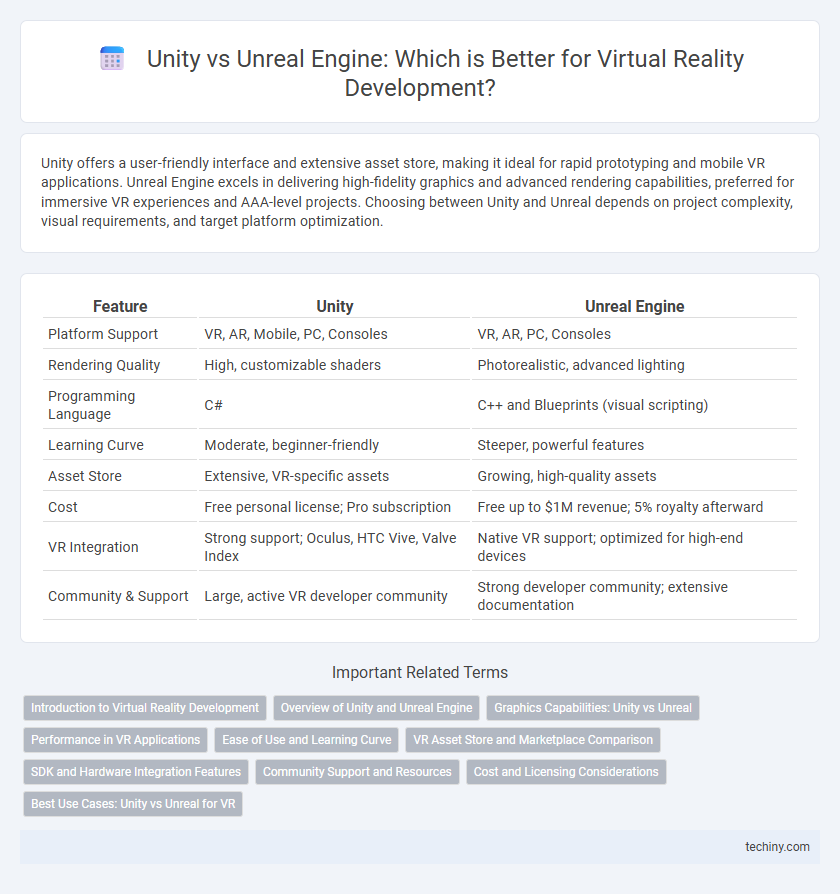Unity offers a user-friendly interface and extensive asset store, making it ideal for rapid prototyping and mobile VR applications. Unreal Engine excels in delivering high-fidelity graphics and advanced rendering capabilities, preferred for immersive VR experiences and AAA-level projects. Choosing between Unity and Unreal depends on project complexity, visual requirements, and target platform optimization.
Table of Comparison
| Feature | Unity | Unreal Engine |
|---|---|---|
| Platform Support | VR, AR, Mobile, PC, Consoles | VR, AR, PC, Consoles |
| Rendering Quality | High, customizable shaders | Photorealistic, advanced lighting |
| Programming Language | C# | C++ and Blueprints (visual scripting) |
| Learning Curve | Moderate, beginner-friendly | Steeper, powerful features |
| Asset Store | Extensive, VR-specific assets | Growing, high-quality assets |
| Cost | Free personal license; Pro subscription | Free up to $1M revenue; 5% royalty afterward |
| VR Integration | Strong support; Oculus, HTC Vive, Valve Index | Native VR support; optimized for high-end devices |
| Community & Support | Large, active VR developer community | Strong developer community; extensive documentation |
Introduction to Virtual Reality Development
Unity and Unreal Engine are leading platforms for virtual reality development, each offering unique tools for immersive experiences. Unity excels with its extensive asset store, user-friendly interface, and C# scripting, making it ideal for beginners and rapid prototyping. Unreal Engine provides superior graphical fidelity and powerful Blueprint visual scripting, favored by developers aiming for high-quality VR visuals and performance.
Overview of Unity and Unreal Engine
Unity offers a versatile and user-friendly platform widely used for virtual reality development, featuring an extensive asset store and strong community support that accelerates project timelines. Unreal Engine excels with cutting-edge graphics capabilities and built-in VR tools, providing high-fidelity visuals ideal for immersive VR experiences. Both engines support multiple VR platforms, but Unity is often preferred for rapid prototyping while Unreal is favored for photorealistic rendering.
Graphics Capabilities: Unity vs Unreal
Unreal Engine offers superior graphics capabilities for virtual reality projects, featuring advanced rendering techniques like real-time ray tracing and photorealistic lighting that enhance immersion. Unity supports high-quality visuals with flexible shaders and post-processing effects but generally lags behind Unreal in achieving cinematic-level graphics fidelity. Developers prioritizing cutting-edge graphics and visual realism in VR often opt for Unreal Engine due to its robust graphical feature set and optimized performance for complex environments.
Performance in VR Applications
Unity offers optimized VR performance with efficient rendering pipelines and lightweight asset management, making it suitable for mobile and standalone VR devices. Unreal Engine excels in high-fidelity VR experiences by leveraging its advanced graphics capabilities and powerful optimization tools, which benefit high-end VR hardware. Both engines support multi-threading and VR-specific features, but Unreal's native support for ray tracing often delivers superior visual quality with potential performance trade-offs on lower-end devices.
Ease of Use and Learning Curve
Unity offers a more accessible interface and extensive documentation, making it ideal for beginners in virtual reality development, while Unreal Engine provides advanced features but requires a steeper learning curve due to its complex Blueprint system. Unity's vast asset store and supportive community accelerate the development process, whereas Unreal Engine excels in photorealistic rendering but demands more programming knowledge. Developers opting for ease of use typically prefer Unity for rapid prototyping and VR projects with limited experience.
VR Asset Store and Marketplace Comparison
Unity's Asset Store offers a vast selection of VR-specific assets, including optimized 3D models, shaders, and VR interaction scripts that streamline development for various VR platforms. Unreal Engine's Marketplace features high-quality, photorealistic assets and robust VR template projects tailored for immersive experiences, with strong support for advanced lighting and physics. While Unity excels in quantity and platform versatility, Unreal provides superior graphical fidelity and out-of-the-box VR tools, making the choice dependent on project scope and visual requirements.
SDK and Hardware Integration Features
Unity offers extensive SDK support and seamless integration with popular VR hardware like Oculus, HTC Vive, and Valve Index, simplifying VR development and deployment. Unreal Engine excels in high-fidelity rendering and provides native SDK integration with leading VR platforms, enabling advanced hardware features such as eye-tracking and haptic feedback. Both engines support cross-platform VR development, but Unreal's robust hardware optimization suits projects demanding photorealistic visuals and complex interactions.
Community Support and Resources
Unity offers a vast and active community with extensive forums, tutorials, and asset store resources that cater to developers of all skill levels in Virtual Reality projects. Unreal Engine provides robust support through a dedicated developer network, comprehensive documentation, and frequent updates, emphasizing high-fidelity VR experiences. Both platforms ensure strong community engagement, but Unity's broader user base often results in faster problem-solving and a richer repository of VR-specific resources.
Cost and Licensing Considerations
Unity offers a subscription-based pricing model with tiers like Personal, Plus, and Pro, catering to individual developers and enterprises, while its free version allows access to core VR features but limits revenue. Unreal Engine provides a royalty-based license, charging 5% on gross revenue after the first $1 million per product, making it cost-effective for smaller projects and startups. Both engines support VR development extensively, but the choice depends on project scale, budget flexibility, and long-term revenue projections.
Best Use Cases: Unity vs Unreal for VR
Unity excels in mobile VR and AR applications due to its lightweight engine, extensive cross-platform support, and vast asset store, making it ideal for fast prototyping and smaller-scale projects. Unreal Engine offers superior graphical fidelity and performance for high-end VR experiences, particularly suited for architecturally realistic simulations, AAA games, and detailed interactive environments. Developers often choose Unity for scalability and flexibility, while Unreal is preferred when photorealism and advanced visual effects are critical in VR development.
Unity vs Unreal Engine Infographic

 techiny.com
techiny.com